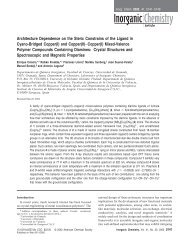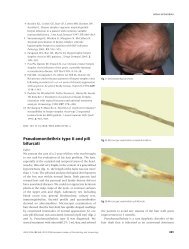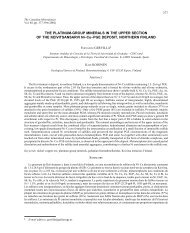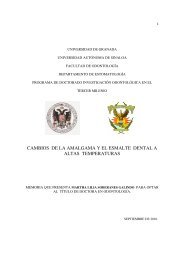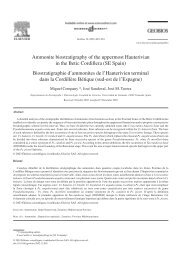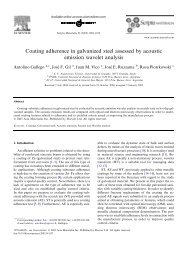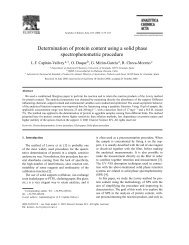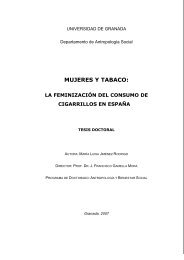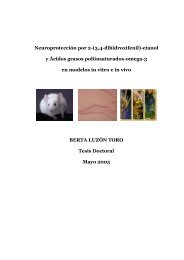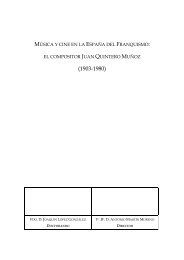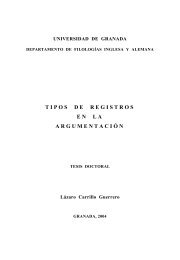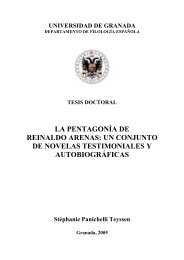Jurassic biostratigraphy and paleoenvironmental evolution of the ...
Jurassic biostratigraphy and paleoenvironmental evolution of the ...
Jurassic biostratigraphy and paleoenvironmental evolution of the ...
You also want an ePaper? Increase the reach of your titles
YUMPU automatically turns print PDFs into web optimized ePapers that Google loves.
26 J.E. Caracuel et al. / Geobios 39 (2006) 25–42<br />
Cornacaldense), Algovianum (sous-zones à Ragazzoni, Bertr<strong>and</strong>i, Accuratum et Levidorsatum) et Emaciatum (sous-zones à Solare et Elisa)<br />
dans le Domérien; les zones à Polymorphum et Serpentinum dans le Toarcien inférieur ; les Zones à Bifrons et Gradata dans le Toarcien moyen<br />
et la Zone à Reynesi dans le Toarcien supérieur ; la partie supérieur du Bajocien inférieur et le Bajocien supérieur ; le Callovien inférieur,<br />
Zones à Bullatus et Gracilis ; les Zones à Transversarium, Bifurcatus, Bimammatum et Planula dans l’Oxfordien moyen/supérieur et les Zones<br />
à Platynota, Strombecki, Divisum et Beckeri dans le Kimméridgien.<br />
L’évolution de l’environnement du Jurassique Malaguide dans la Sierra Espuña montre beaucoup d’affinités avec les autres paléomarges<br />
de la Téthys méditerranéenne. La précision biostratigraphique et l’analyse des lith<strong>of</strong>aciès et des bi<strong>of</strong>aciès nous ont permis d’interpréter la<br />
paléomarge Malaguide comme une paléomarge passive, avec le développement d’une plate-forme carbonatée sommaire jusqu’au Domérien<br />
(Zone à Lavinianum). Ensuite eut lieu la fracturation de cette plate-forme (Domérien inférieur, Zone à Levinianum-Toarcien supérieur, Zone<br />
à Reynesi) liée au commencement de la phase de « rifting », caractérisée par le développement d’un système de horsts et grabens et l’enfoncement<br />
de cette région. L’extension se poursuit entre le Callovien inférieur (Zone à Gracilis) et l’Oxfordien Moyen (Zone à Transversarium), en<br />
indiquant le début d’une phase de « drifting » qui aurait déclenché la réactivation du système de horsts et grabens, conduisant au dépôt de<br />
calcaires nodulaires condensés dans les parties les plus élevées du fond marin.<br />
© 2005 Elsevier SAS. All rights reserved.<br />
Keywords: <strong>Jurassic</strong>; Ammonite <strong>biostratigraphy</strong>; Paleoenvironmental <strong>evolution</strong>; Internal Betic Zone; Malaguide Complex; Sou<strong>the</strong>astern Spain<br />
Mots clés : Jurassique ; Biostratigraphie des ammonites ; Évolution de l’environnement ; Zone Interne Bétique ; Complexe Malaguide ; Sud-Est de l’Espagne<br />
1. Introduction<br />
The <strong>Jurassic</strong> <strong>evolution</strong> <strong>of</strong> <strong>the</strong> Betic Cordillera took place<br />
under distensive tectonic conditions related to Tethyan rifting.<br />
Although, <strong>the</strong> rifting age has been considered quite similar<br />
throughout <strong>the</strong> cordillera, controversy continues concerning<br />
<strong>the</strong> synchronism versus diachronism for <strong>the</strong> pre-, syn<strong>and</strong><br />
postrifting periods in <strong>the</strong> different domains into which<br />
<strong>the</strong> Betic Cordillera has traditionally been divided: <strong>the</strong> Internal<br />
<strong>and</strong> <strong>the</strong> External Zones.<br />
The External Zones belong to <strong>the</strong> South Iberian Paleomargin<br />
<strong>and</strong> consist <strong>of</strong> post-Triassic unmetamorphosed rocks.<br />
Thus, <strong>the</strong> <strong>Jurassic</strong> paleogeographic <strong>evolution</strong> <strong>and</strong> <strong>the</strong> age <strong>of</strong><br />
<strong>the</strong> onset <strong>of</strong> <strong>the</strong> rifting (Carixian = Lower Pliensbachian), <strong>and</strong><br />
<strong>the</strong> post-rifting phase (boundary Middle/Upper <strong>Jurassic</strong>) has<br />
been well-characterized (Vera, 1988). On <strong>the</strong> contrary, <strong>the</strong><br />
Internal Betic Zones belong to a microplate (Mesomediterranean<br />
Terrain, Guerrera et al., 1993) derived from <strong>the</strong> North<br />
African continental margin, which collided against <strong>the</strong> External<br />
Zones during <strong>the</strong> Early Miocene. These zones are built up<br />
by <strong>the</strong> stacking <strong>of</strong> four complexes (in order upwards): Nevad<strong>of</strong>ilabride,<br />
Alpujarride, Malaguide <strong>and</strong> “Dorsal”. The Nevad<strong>of</strong>ilabride<br />
<strong>and</strong> Alpujarride are composed mainly <strong>of</strong> Paleozoic<br />
<strong>and</strong> Triassic (<strong>and</strong> older), metamorphic rocks, while <strong>the</strong><br />
Malaguide <strong>and</strong> “Dorsal” Complexes include unmetamorphosed<br />
Paleozoic (Malaguide) <strong>and</strong> Meso-Cenozoic (Malaguide<br />
<strong>and</strong> “Dorsal”) sedimentary rocks. In general, <strong>the</strong> scarcity<br />
<strong>of</strong> <strong>Jurassic</strong> unmetamorphosed successions, toge<strong>the</strong>r with <strong>the</strong><br />
intense tectonic activity, have hampered <strong>the</strong> dating <strong>of</strong> <strong>the</strong> main<br />
<strong>Jurassic</strong> events in <strong>the</strong> Internal Zones.<br />
The Malaguide is <strong>the</strong> uppermost Complex (<strong>and</strong>, consequently,<br />
<strong>the</strong> most internal) <strong>of</strong> <strong>the</strong> Internal Zones, which outcrops<br />
mainly from Malaga Province (westward) to Murcia<br />
Province (eastward). In contrast to <strong>the</strong> o<strong>the</strong>r complexes, <strong>the</strong><br />
Malaguide Complex includes <strong>Jurassic</strong> sedimentary covers,<br />
favoring <strong>the</strong> analysis <strong>of</strong> <strong>the</strong> <strong>Jurassic</strong> <strong>evolution</strong> <strong>of</strong> <strong>the</strong> Internal<br />
Betic Zones. The Sierra Espuña area, in Murcia Province, is<br />
probably <strong>the</strong> most extensive, <strong>and</strong> <strong>the</strong> best exposed <strong>Jurassic</strong><br />
outcrop belonging to <strong>the</strong> Malaguide in <strong>the</strong> Betic Cordillera.<br />
Except for <strong>the</strong> pioneer work by Fallot (1945), <strong>the</strong> main<br />
papers on <strong>the</strong> <strong>Jurassic</strong> <strong>of</strong> Sierra Espuña are from <strong>the</strong> 1960s<br />
<strong>and</strong> 1970s (Peyre <strong>and</strong> Peyre, 1960; Mac Gillavry et al., 1963;<br />
Navarro <strong>and</strong> Trigueros, 1963; Paquet, 1962, 1969; Geyer <strong>and</strong><br />
Hinkelbein, 1971, 1974; Kampchuur et al., 1974; Seyfried,<br />
1978, among o<strong>the</strong>rs). Almost no recent studies have been<br />
made on <strong>the</strong> <strong>biostratigraphy</strong> <strong>and</strong> <strong>the</strong> paleogeographic <strong>evolution</strong><br />
<strong>of</strong> <strong>the</strong> <strong>Jurassic</strong> <strong>of</strong> Sierra Espuña. In <strong>the</strong> present work, we<br />
analyze some classical <strong>Jurassic</strong> sections, toge<strong>the</strong>r with new<br />
sections, in order to update <strong>the</strong> biostratigraphic framework<br />
<strong>and</strong> to approach <strong>the</strong> <strong>paleoenvironmental</strong> <strong>evolution</strong> <strong>of</strong> <strong>the</strong><br />
<strong>Jurassic</strong> Malaguide from Sierra Espuña. Moreover, this will<br />
improve <strong>the</strong> knowledge <strong>of</strong> <strong>the</strong> <strong>Jurassic</strong> <strong>of</strong> <strong>the</strong> Internal Betic<br />
Zones, in addition to providing a fuller underst<strong>and</strong>ing <strong>of</strong> <strong>the</strong><br />
External Betic Zones, <strong>and</strong> <strong>the</strong>ir relationships.<br />
2. Geographical <strong>and</strong> geological setting<br />
The Sierra Espuña area is located in Murcia Province,<br />
accessible by road from <strong>the</strong> villages <strong>of</strong> Alhama <strong>and</strong> Totana,<br />
from <strong>the</strong> south, <strong>and</strong> Mula from <strong>the</strong> north (Fig. 1). The Malaguide<br />
outcropping area <strong>of</strong> Sierra Espuña bounds tectonically<br />
with <strong>the</strong> Alpujarride Complex to <strong>the</strong> SE, <strong>and</strong> with <strong>the</strong> External<br />
Betic Zones (Subbetic) to <strong>the</strong> NW. Laterally, <strong>the</strong> nearest<br />
outcrop <strong>of</strong> <strong>Jurassic</strong> Malaguide in <strong>the</strong> region is located 40 km<br />
westward, near Vélez Rubio in <strong>the</strong> Province <strong>of</strong> Almeria<br />
(Castillón Fm., Geel, 1973).<br />
The outcropping Malaguide Complex in Sierra Espuña is<br />
composed <strong>of</strong> two tectonic units (Martín-Martín, 1996); Morrón<br />
de Totana <strong>and</strong> Perona (Fig. 1). The Morrón de Totana<br />
Unit is <strong>the</strong> footwall while <strong>the</strong> Perona Unit is <strong>the</strong> hanging wall,<br />
which, paleogeographically came from a more proximal position<br />
(Martín-Martín <strong>and</strong> Martín-Algarra, 1997). Both units<br />
include a marine <strong>Jurassic</strong> sedimentary cover, although in <strong>the</strong>



